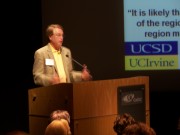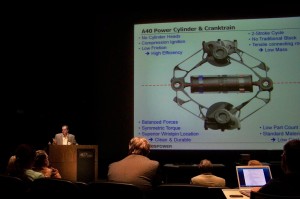Xconomy Forum Calls for Bold Leadership and Collaboration in Smart Energy
By Tiffany Fox, (858) 246-0353, tfox@ucsd.edu
San Diego, June 30, 2010 — The post-World War II rise of America to its current superpower status was made possible by widespread use of inexpensive, seemingly inexhaustible oil, natural gas and coal. Yet the U.S. domestic oil production peaked forty years ago and many predict that global oil production will peak this decade. Although this cheap, abundant energy at America's disposal has fueled unprecedented economic growth, it has also paved the way for environmental destruction in the form of urban sprawl, oil spills, and coal strip mining — creating the specter of global climatic disruption for centuries to come.
|
During his keynote presentation at the event, Internet pioneer and Calit2 Director Larry Smarr warned that our society is "taking the planet into a climate regime that hasn't been seen as long as humans have been on Earth." Smarr cited research from the Scripps Institution of Oceanography, the World Meteorological Association, the Global Change Research Program Report, the California Climate Change Center, and others to make the case for a "quantitative road map" to a low carbon economy that includes: reducing annual carbon dioxide emissions 50 percent by 2050; balancing the removal of cooling aerosols with the removal of warming black carbon and ozone; greatly reducing emissions of short-lived greenhouse gases; quickly scaling up alternative energy; electrifying the transportation system, and widely adopting carbon sequestration for coal.
Smarr is also a co-principal investigator on the National Science Foundation-funded GreenLight project, which is developing better ways to measure and mitigate energy consumption by various types of computing devices and applications. In his speech, the Calit2 director advocated for an increased role to be played by those who work in information and communications technologies (ICT).
|
Smarr's overview of the potential for collaboration between ICT and the energy industries set the tone for a panel discussion on “Innovations in Smart Energy Sensing, IT and Analytics,” moderated by Brian Kremer of investment banking firm Roth Capital Partners. The panelists included Jan Kleissl, an assistant professor of mechanical and aerospace engineering at UC San Diego; Alex Guazzelli of San Diego's Zementis (which specializes in predictive analytics, data mining and decision management), and Terry Mohn of Balance Energy (an end-to-end provider of resilient distributed generation solutions for utilities, municipalities, and commercial customers).
By way of introduction, Kremer pointed out that in 2009, clean energy technologies received a quarter of all venture capital funding, beating out biotechnology and software, and clean tech was again the largest recipient of venture capital in the first quarter of 2010.
|
Mohn suggested that the states themselves are "starting to mandate change because they're tired of waiting for the federal government and international organizations." In the near future, he noted, energy will move from remote generation to generation on site, with collaboration from the state utilities.
"The current utility model is broken," stated the Balance Energy executive. "The only way you know the cost of the energy you use is by looking at the bill. As distributed generation becomes more prevalent, the system that we have to manage power delivery today is not going to work. We need analytics to figure out how to start to move the flow of power to accommodate neighborhoods that can generate and manage their own power and supply excess capacity. Consumers will then become interested in real market rates for power, and we'll see transition to new microgrid ecosystem.
"New rules will need to be put in place for generation and storage so we have efficient production and consumption of energy," Mohn added. "The really cool thing is that San Diego is at the hub of all of this."
Kleissl's research into improving the efficiency of photovoltaic (solar) energy cells is one example of UC San Diego's contribution to the statewide effort. As Kleissl pointed out, California's 2020 mandate calls for public utilities to generate 30 percent of their resources from renewable energy in the next 10 years, and that means that solar forecasting will become of prime importance.
The Jacobs School of Engineering professor has built computer models for forecasting cloud cover, which can be used to develop cloud maps and predict where clouds are moving. He said that new tools for solar forecasting are needed, especially those that can aggregate sky imagery from satellites with ground measurements of photovoltaic output. Kleissl’s call for increased data was echoed by Mohn, who cited a recent study that found that a single cloud passing over a solar panel can cause voltage to fluctuate by more than 1000 volts which could potentially damage transformers.
Alex Guazzelli of Zementis discussed the ways that his company, which specializes in predictive analytics, can work hand-in-hand with the public utilities as they move toward the generation of renewable energy.
"When a credit card company calls you to see if you really made a transaction or if it was fraud, when Netflix makes recommendations based on your viewing history, that's predictive analytics," explained Guazzelli. "As you can tell, predictive analytics really permeates our lives today. We are collecting large amounts of data and our predictions can happen in real time, which is key for the smart grid.
"Because predictive analytics tells us what will happen next," he continued, "it allows us to do predictive maintenance — to send a crew out to replace a transformer before it actually breaks, to prevent energy theft, and so on. But just seeing the data is not enough. In order to get it to the level of smartness that we want, we need quality data."
|
But with increased data comes increased privacy risks to the homeowner, Pitt warned.
"Privacy matters. Detailed energy usage data is very private, and the possibilities for abuse are many and varied.” Pitt originally considered hosting the data generated by FIDO in the cloud, for example, but he reconsidered when he realized that the data would reveal personal habits. "We were able to tell that the homeowner had a glass of milk at midnight,” he said, “because we could see the change in energy use when the refrigerator door opened.” Instead, FIDO sends the information to the user's personal computer.
Turning the focus from supply management at the consumer level to that of the regional level, Jonas Olsen of Onramp Wireless described his company's focus on developing wireless sensors for wide deployment. His firm has developed a new wireless technology called Ultra-Link that uses a novel signal-processing technique to collect data from devices. By developing a new physical layer and new air interface, Onramp has been able to demodulate wireless signals and exploit an extremely weak signal, which could potentially enable them to provide wireless coverage of the entire San Diego region for less than $1 million. The technology could enable a host of energy-management applications, such as streetlight monitoring, substation monitoring and electricity, gas and water monitoring.
|
"We see a big opportunity for a more efficient engine that's cleaner," Johnson remarked. "The economic push for these types of technologies has not been great because we've been suckled on low-price energy and fuel. But if we're going to achieve sustainability – if humans are going to live happily ever after on this planet – we need to be smart in two different disciplines: science and economics."
Electric hybrids were the topic of a presentation delivered by Manuel Jaime of Qualcomm, who explained how wireless wide area networks (WAN) can provide utilities with real-time, localized control of the power grid.
When it comes to managing electricity for electric vehicles, Jaime explained that there are three key stakeholders. "First are the utilities, which have energy concerns if everyone plugs their hybrid vehicle in at the same time," he said. "The increase in capacity that the utility would have to provide is a nontrivial challenge.
"But these vehicles also pose challenges for charge-station management and for electric vehicle energy rates and metering. And for consumers, there are the notions of cost, infrastructure availability and range anxiety," despite 80 percent of all daily, round-trip average commutes being less than 50 miles, Jaime noted.
With the real-time measuring capabilities of WAN and the smart grid, consumers could theoretically charge their electric vehicles early in the morning using energy from a solar power plant. When the evening cloud cover rolls in and offshore winds pick up, utilities could control supply and demand in real time by using the WAN to shift the supply of power to wind energy.
"The main point is that it's a very dynamic system," remarked Jaime. "But if you cannot measure the data and transmit the data in real time, the whole system falls apart."
The final presentation of the evening came from Eric Giler, the CEO of WiTricity, which has developed a technology that uses magnetic induction and resonant frequency to transmit electricity wirelessly over short distances. Not only does the technology have implications for electric vehicles, which can be charged more safely and easily with the device, but WiTricity can also eliminate the need for disposable batteries, which are inefficient and contribute to problems in landfills.
"We humans love electricity, and to power our mobile devices we buy 40 billion disposable batteries per year," Giler stated. "The AA battery might seem like one of the most innocent things you can imagine but it's wicked expensive electricity, running at $250 to $350 per kilowatt hour. You put a few of those in a wireless keyboard and you're using it within 10 inches of 10-cent per kilowatt-hour grid energy, probably because you knocked your coffee cup over with the wire one day."
Giler added that the hassles of plugging in electric vehicles are even more pronounced — and potentially dangerous.
"Do we really want plug-in cars?" he asked. "Consumers worry: Will I forget to plug it in? Will I forget to unplug it? Am I physically capable of plugging it in? Do I want to plug it in during bad weather? Do I want to get my hands and clothes dirty? Do I want to plug it in in a public place?
"Imagine if you could put a mat on the floor of your garage and you pull in and your car starts charging,” added Giler, noting that parking lots could also be equipped with the WiTricity mats, which work by transmitting electricity between two coils that are tuned to the same resonant frequency.
“The market innovations described today at the Xconomy Forum are just what is needed to drive the dramatic changes required,” noted Calit2 director Smarr in his closing remarks, “in our economy to stem the generation of greenhouse gases and limit the scale of future climatic disruption.” When asked by someone in the audience what he would do if he were U.S. president, Smarr did not hesitate to reply.
"I would declare an immediate moratorium on drilling new oil wells, creating new coal mines, and set a national goal to phase out imported oil within 10 years.” “Of course," he added, "that would drive the price of carbon sharply upward and put a tremendous strain on the market, but that kind of radical change in the market structure has to happen so that entrepreneurs and investors will rapidly build up a low-carbon energy system to replace our current unsustainable high-carbon system. Otherwise, we'll do with fossil fuels what we've done with overfishing, which is to ignore the warning until it is too late to avoid an economic crash."
Media Contacts
Tiffany Fox, (858) 246-0353, tfox@ucsd.edu
Related Links



